Genre: Fighting Developer: Sega of Japan Publisher: Sega of Japan Players: 1-2 Released: 1993
Sumo wrestlers don’t fare very well in video games. Street Fighter II‘s E. Honda did okay for himself, but Virtua Fighter 3‘s Taka seemed to disappear into the Springfield Mystery Spot along with Ozzie Smith, never to return. Despite the popularity of sumo wrestling in Japan, it would appear that it only warrants a single representation on each system. Aah! Harimanada, a game based on a twenty-three episode Japanese animation series and manga, fills that void on the Sega Mega Drive.
Aah! Harimanada is a territory blocked Japanese import sumo fighting game in the mold of Street Fighter II with exaggerated attacks and acrobatics. The game features 15 rikishi (sumo wrestlers) capable of striking with flaming palms, bench pressing fellow 400 lb. plus opponents, and leaping two or three stories into the air. For what remains a deeply ritual sport backed by hundreds of years of tradition, the sumo wrestling depicted here almost seems blasphemous. While that’s hardly a concern to the video game player, these liberties do hurt the game from being either a pure sumo wrestling simulation or a worthwhile fighting game.
For the uninitiated, sumo wrestling is a sport where two men and a gyouji (referee) enter a dohyo (circular ring), each wrestler attempting to knock his opponent out of the ring or have his body contact the ground. Sumo wrestling is very much a sport of positioning and balance, and, unfortunately for Aah! Harimanada, that just doesn’t translate well into a flat 2-D fighting game engine. While the basic rules remain the same – toss the opponent out or deplete his life meter with attacks to have him touch the ground to win – the flat presentation, poor gameplay, and lack of balance make for a shallow game.
Weight appears to have no factor in the game other than jump height, with the lighter fighters capable of leaping nearly two screens high. With no 3D movement available, the only method of moving around the dohyo is to leap over the opponent or grapple to switch places. Leaping leaves the player open to a strike which can send him out the ring, and the grappling mechanics are so poorly implemented that the outcome is always up to chance. Lots of times the wrestlers will lock arms and struggle while the two-frame animation loops incessantly with no real way to see who is winning the battle. Matches appear to be guided more by fate than skill, and the relative ease of ring outs can make playing all the more annoying. Worse is that the game only allows three continues in its single player story mode, making progressing through the game all the more infuriating.
There are fifteen rikishi to select from, though the game’s single player story mode focuses on Harimanada. Despite the number of available wrestlers, the sprites just cycle through three body types (medium, large, and biggie-sized), with the only visible change coming from the pre-match character portrait. The cast shares the same move set (which some minor visual changes), so aside from the differences in height and girth, there is little variance among the cast. The A-button performs quick palm strikes, the B-button unleashes heavy attacks and special moves, and the C-button initiates a grapple; and all moves unfold the same regardless of the attacking character and the physique of the target. Special moves utilize Street Fighter II-style D-pad motions and are not nearly as reliable and effective as the basic strikes. Poor control and shoddy gameplay turn what could have been an interesting take on a fighting game into a braindead button masher.
There isn’t much to see while mashing through the game’s rikishi, either. The graphics are flat and repetitive, and the lack of unique character sprites and other dohyo really hurt the game. Animation is limited to two to four frames at best. While the game looks pretty good in still shots, witnessing it in motion (or lack thereof) quickly changes one’s perception. Aside from the gyouji who moves about the dohyo, there is no background animation whatsoever. The lifeless crowd remains a permanent, unchanging backdrop while the action unfolds. I can only imagine they’re sleeping since the matches have the same excitement of a coin toss.
The soundtrack is varied but never rises above the game’s mediocre production values. With a bit over twenty songs, some really out of place sound effects and sampling of scratchy digitized voice, the game offers more variety in its sound test than it does the actual game. The game does do a good job of not allowing the constant button mashing and associated sound effects to overpower the background music, but that’s a shallow victory no one playing will appreciate. I can only assume the soundtrack is lifted from the Aah! Harimanada animation series, and these renditions do not make me interested in checking out the original soundtrack one bit.
Since the series has not been released outside Japan to my knowledge, it’s safe to say that the interest in this game abroad is nil. It fails as a sumo wrestling game, and it fails as a worthwhile one-on-one fighter. The only thing Aah! Harimanada has going for it is its theme, and that just isn’t enough to carry such a subpar title. There are far better wrestling and button mashing choices on the system, and anyone craving a 16-bit sumo wrestler is better off just sticking with E. Honda instead.
SCORE: 2 out of 10


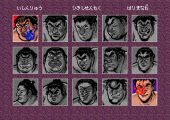
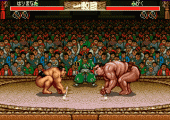
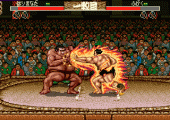
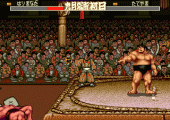
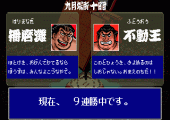
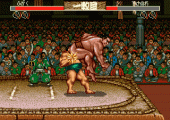
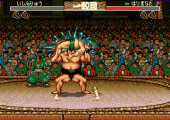
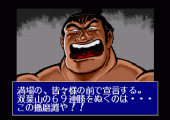
Recent Comments